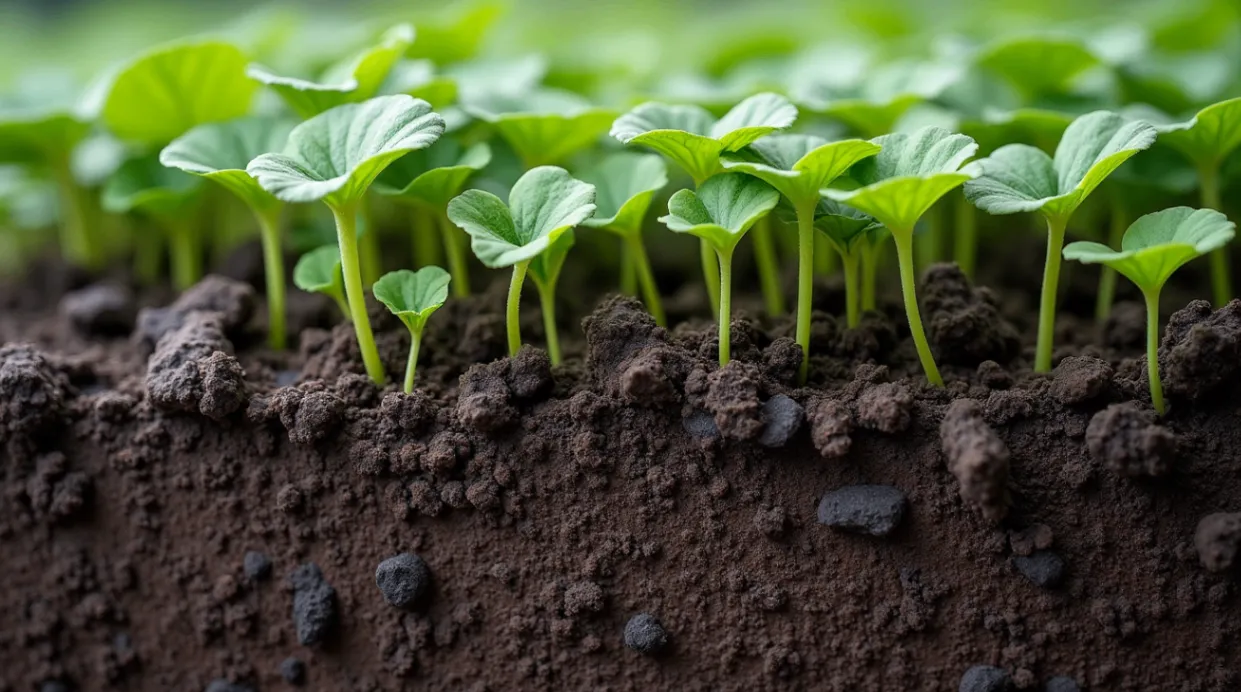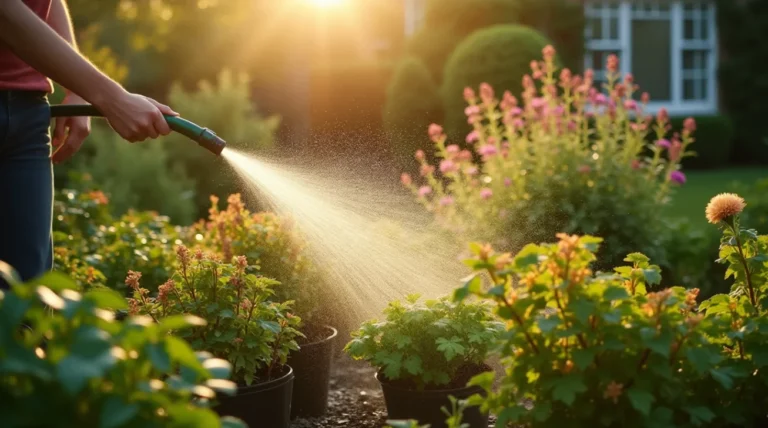Coals Effect On Soil: How To Restore Affected Land
Coal mining and processing harm the environment, including soil pollution. This is a big problem for land affected by coal. We need to pay attention and take action. In this article, we’ll look at how coal affects soil and how to fix it.
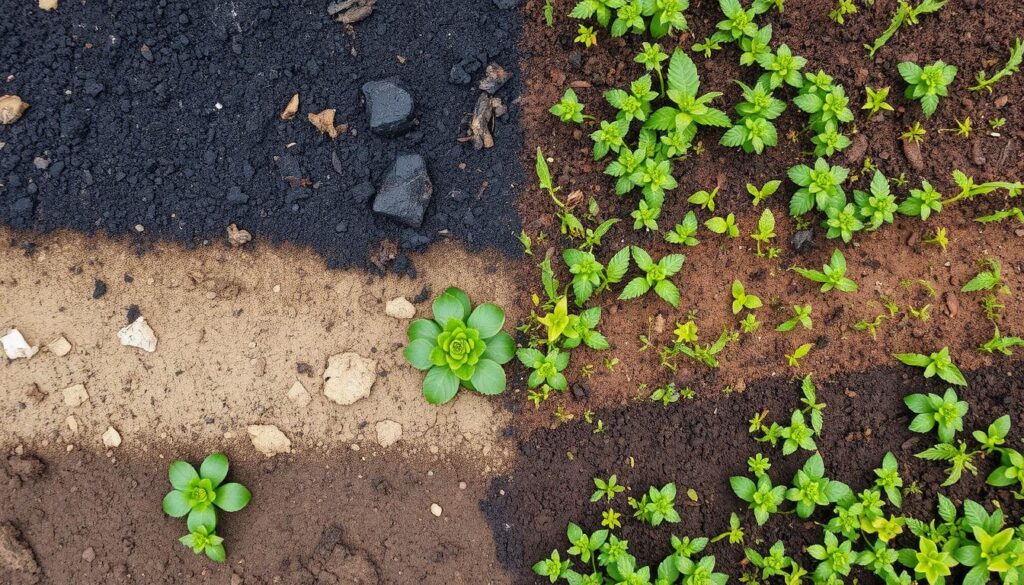
This article aims to teach you about coal’s impact on soil. It’s important to test and analyze soil affected by coal. By knowing the changes in coal-affected soil, we can find ways to restore it.
Key Takeaways
- Coal mining and processing can pollute soil and affect the environment
- Coals effect on soil is a critical issue that requires attention and action
- Proper soil testing and analysis are essential for restoring coal affected land
- Understanding the chemical and physical changes in coal-affected soil is crucial for effective restoration
- Restoration strategies can help mitigate the negative impacts of coal on soil and the environment
- Effective restoration of coal affected land requires a comprehensive approach
Understanding Coal’s Impact on Soil Chemistry
Coal mining and processing can change soil chemistry a lot. This leads to changes in pH levels and mineral content. These changes can harm the environment and ecosystem for a long time.
The soil pH changes caused by coal mining are big problems. Acid mine drainage is a common issue. Acidic water from coal mines flows into nearby waterways, changing soil pH and affecting the local ecosystem. It’s important to understand these changes to develop effective restoration strategies.
pH Level Changes in Coal-Affected Soil
Coal mining can make soil more acidic. This happens because of sulfuric acid and other acidic compounds released during mining. The soil’s ability to support plant growth is greatly affected by these pH changes.
Mineral Content Alterations
Coal mining also changes the soil’s mineral content. This affects the availability of essential nutrients for plants. Plants may struggle to grow in soil with altered mineral content, impacting the local ecosystem.
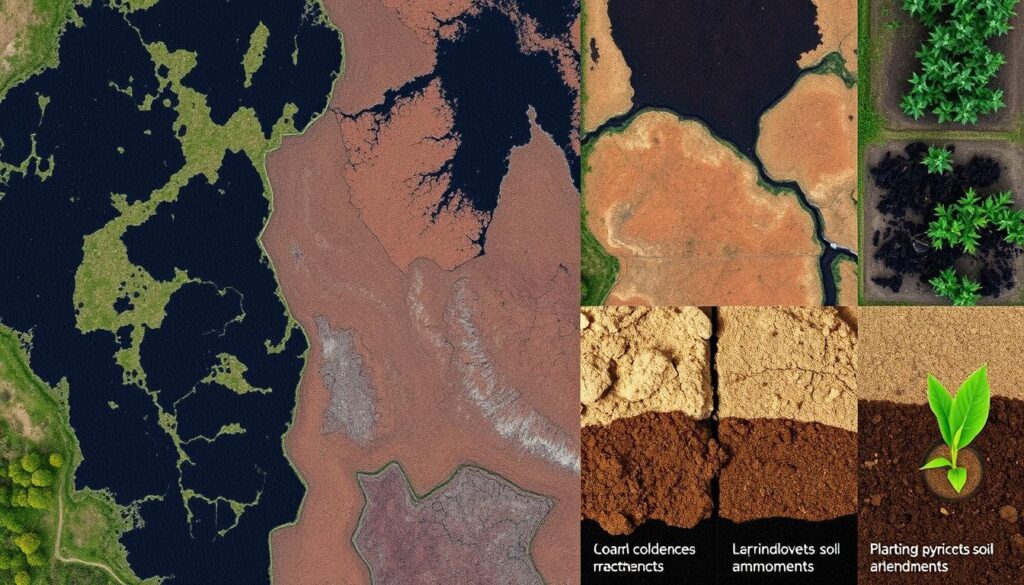
Heavy Metal Contamination Patterns
Coal mining can also lead to heavy metal contamination. Toxic metals like lead and mercury are released into the soil. These metals can be harmful to plants and animals, posing serious risks to the local ecosystem.
| Soil Parameter | Pre-Mining | Post-Mining |
|---|---|---|
| pH Level | 6.5-7.5 | 4.5-5.5 |
| Mineral Content | Balanced | Altered |
| Heavy Metal Contamination | Low | High |
Physical Changes in Coal-Contaminated Soil
Coal contamination can change soil a lot. It affects the soil’s texture, structure, and how it holds water. These changes make it hard for plants to grow. The soil’s health and fertility can suffer greatly.
Some key changes in coal-contaminated soil include:
- Soil texture changes, making it more likely to erode
- Soil structure changes, affecting water and air
- Soil becomes less porous, making it hard for roots to grow
These changes are bad for the soil. They can make it hard to grow plants. Understanding these changes is key to fixing the soil.
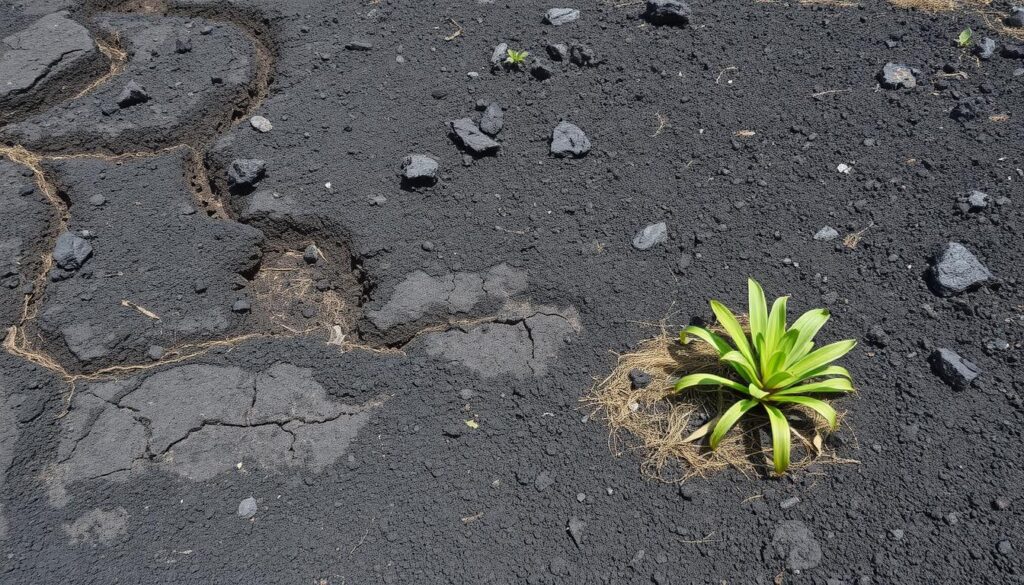
To fix coal-contaminated soil, we need to tackle these changes. Adding organic matter can help. This improves the soil’s structure and fertility. By fixing these issues, we can make the soil healthy again.
| Physical Change | Impact on Soil Health |
|---|---|
| Changes in soil texture | Increased risk of erosion |
| Alterations in soil structure | Impacted water-holding capacity and aeration |
| Decreased porosity | Limited ability to support plant roots |
Coal’s Effect On Soil Microorganisms and Biodiversity
The impact of coal on soil microorganisms is a big worry. These tiny life forms are key to keeping soil healthy. Losing them can harm the whole ecosystem.
Coal pollution can change the soil’s chemistry. This makes it hard for these tiny creatures to survive.
Studies have found that coal pollution can hurt soil health. This affects how well plants grow. To fix this, we can add organic matter and create a buffer zone. This helps keep the soil healthy and supports good microorganisms.
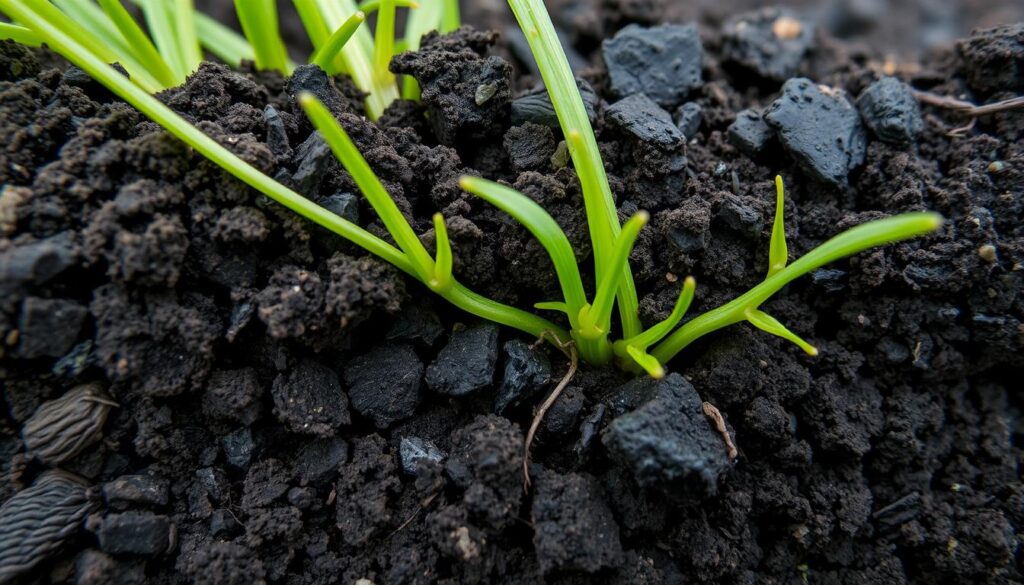
- Changes in soil pH levels
- Alterations in mineral content
- Heavy metal contamination
These changes hurt soil biodiversity. It’s important to watch and fix these issues to keep the soil healthy.
Knowing how coal affects soil microorganisms is key to fixing it. By keeping the soil diverse and supporting good microorganisms, we can restore the ecosystem. This leads to better land use and sustainability.
Identifying Signs of Coal-Affected Soil
Coal affected soil signs can be subtle but very important. A change in soil color is a key sign. It can range from a slight darkening to a complete discoloration. This change often makes the soil more prone to erosion or waterlogging.
Another sign is a distinct odor, which can smell sour or metallic. This smell comes from heavy metals or pollutants in the soil. Soil contamination also makes the soil less fertile. This makes it hard for plants to grow or thrive.
- Changes in soil color and texture
- Distinct odors, such as sour or metallic smells
- Decreased soil fertility and plant growth
It’s crucial to identify these signs to develop effective restoration strategies. By recognizing coal affected soil signs and understanding soil contamination, we can fix the soil. This helps restore its natural balance.
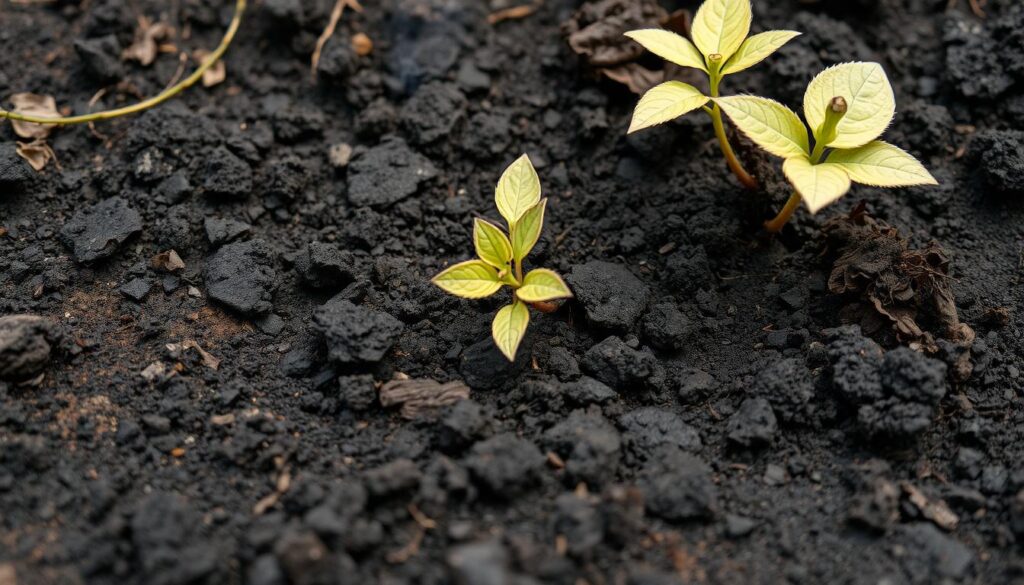
Restoring coal-affected soil needs a detailed approach. It must address the physical, chemical, and biological aspects of soil health. By working together, we can make contaminated land healthy again and support sustainable ecosystems.
Essential Soil Testing Methods for Contaminated Land
Soil testing is key to finding coal contamination and fixing it. When dealing with contaminated land, using different testing methods is vital. This includes soil testing methods like chemical analysis, physical tests, and biological assessments.
These methods help figure out the type and how much contamination there is. For example, chemical tests can find heavy metals. Physical tests check the soil’s pH and nutrients.
- Chemical analysis techniques, such as spectroscopy and chromatography
- Physical property tests, such as soil texture analysis and hydraulic conductivity tests
- Biological assessment methods, such as soil microbial analysis and plant toxicity tests
By using these soil testing methods, we can fully understand the contamination. Then, we can create good plans to fix contaminated land.
Initial Steps in Land Restoration Planning
Restoring coal affected land is key to bringing back its natural state. The first step is to assess how much coal has contaminated the soil. This helps choose the best ways to fix it.
Land restoration planning is very important. It makes sure the restoration is done right and efficiently. Experts check the land to find the best ways to fix the soil’s pH and reduce heavy metals. They also look at how to increase biodiversity.
Some important things to think about in land restoration planning are:
- Checking the soil’s chemistry and physical properties
- Finding out what contaminants are there and how much
- Choosing the best restoration methods for the site
- Creating a plan for when and how much it will cost
With a good plan, coal affected land can be restored. This makes the ecosystem healthy and sustainable.
Good land restoration planning needs to understand the land and the available techniques. By planning carefully, experts can create a detailed plan. This plan tackles the site’s unique problems, leading to a successful restoration.
Soil pH Adjustment Techniques
Adjusting soil pH is key to fixing coal-affected soil. We choose the best method based on soil type and how bad it’s contaminated. These techniques help fix the soil’s chemistry harmed by coal.
To adjust soil pH, we use lime application for acidic soils. We also add organic matter to improve soil health. Creating a buffer zone stops more contamination.
- Lime application methods: This involves applying lime to the soil to raise its pH and reduce acidity.
- Organic matter integration: This approach involves adding organic materials, such as compost or manure, to the soil to improve its structure and fertility.
- Buffer zone creation: This method involves creating a buffer zone around the affected area to prevent further contamination of the soil.
These techniques can make coal-affected soil fertile and productive again. It’s important to keep checking the soil’s pH and contamination levels. This ensures our methods work well.
| Soil pH Adjustment Technique | Description |
|---|---|
| Lime Application | Neutralizes acidic soils |
| Organic Matter Integration | Improves soil structure and fertility |
| Buffer Zone Creation | Prevents further contamination |
Heavy Metal Remediation Strategies
Heavy metal contamination is a big problem in coal contaminated soil. We need to fix it to keep the environment safe. Phytoextraction, phytostabilization, and soil flushing are ways to clean up the soil.
These methods work differently based on the soil and how bad the pollution is. For example, phytoextraction works best for soils with a little pollution. But, phytostabilization is better for very polluted soils.
- Phytoextraction: using plants to absorb heavy metals from the soil
- Phytostabilization: using plants to stabilize heavy metals in the soil, preventing them from leaching into groundwater
- Soil flushing: using water or other solvents to remove heavy metals from the soil
Choosing the right method for cleaning up soil is very important. We need to think about the soil type, how polluted it is, and other environmental factors. This way, we can pick the best method and make the soil healthy again.
| Remediation Method | Soil Type | Contamination Level |
|---|---|---|
| Phytoextraction | Low to moderate | Low to moderate |
| Phytostabilization | High | High |
| Soil Flushing | Any | Any |
Organic Matter Restoration Methods
Improving soil health is key, especially in coal affected areas. This means adding natural materials to the soil. It helps the soil hold water better and supports good microorganisms. This is a major step in fixing coal affected soil.
There are several ways to restore organic matter in coal affected soil. These include:
- Compost application: Adding composted materials like food waste or yard trimmings helps. It improves soil structure and supports beneficial microorganisms.
- Cover crop selection: Growing cover crops between crops helps protect and enrich the soil. They add organic matter and support beneficial microorganisms.
- Mulching techniques: Applying organic material like wood chips or straw helps. It retains moisture, suppresses weeds, and regulates soil temperature.
Choosing the right method depends on the soil type, contamination level, and environment. The right approach can improve soil health and fertility. It also supports plant growth in coal affected soil.
Rebuilding Soil Structure and Stability
Rebuilding soil structure and stability is key to fixing coal affected soil. It makes the soil better at holding water and air. This helps plants and tiny life in the soil to grow well.
Soil structure rebuilding stops soil from washing away. It also helps keep the soil fertile and full of life. This is good for all living things in the soil.
To fix coal affected soil, we use organic stuff like compost or manure. We also use farming methods that don’t hurt the soil too much. These steps help the soil hold together better and stay healthy.
- Adding organic matter, like compost or manure, to make the soil better
- Using farming methods that don’t disturb the soil too much
- Planting cover crops to keep the soil in place
These methods help fix the soil and make it better for the environment. They support healthy ecosystems and biodiversity.
Monitoring Soil Recovery Progress
Soil recovery monitoring is key to seeing if land restoration works. It shows how well the soil is getting better. This helps find areas that need more help.
For soil recovery monitoring, we use soil tests, look at plants, and use remote sensing. These tools give us important info about the soil. This info helps us change our plans to help the soil more.
When checking on soil recovery, look at a few important things:
- Soil pH levels
- Nutrient availability
- Microbial activity
- Vegetation cover and diversity
By watching these, we can see if our efforts are working. This helps us make better choices to improve the soil on coal affected land.
Long-term Management Strategies for Restored Land
Effective long-term management is key to keeping restored land healthy and fertile. It’s about creating a detailed plan that looks at the environment, society, and economy. A good plan keeps the land productive and sustainable for years.
To make this work, we need to focus on a few important things:
- Maintenance schedules to stop erosion and damage
- Steps to keep the land clean from pollution
- Practices that use the land well but protect it too
By using these strategies, restored land can become a place full of life. It helps animals and plants thrive and keeps our environment healthy. This helps not just locally but also helps the world protect nature.
With smart planning and long-term management, restored land can be a treasure for future generations. It offers many benefits, supports life, and helps us build a better future.
Conclusion
The effects of coal on soil can be lasting. Yet, this article shows that damaged land can be fixed. With the right steps, we can make soil healthy again.
Soil restoration is a big task, but it’s worth it. It helps fix the damage from coal mining. It also makes land better for plants and animals to live.
Working together, we can make a difference. Policymakers, businesses, and communities must join forces. This way, we can heal the soil and protect our environment for the future.
FAQ
What are the main effects of coal on soil chemistry?
Coal mining and processing can change soil chemistry a lot. This includes changes in pH levels, mineral content, and heavy metal contamination. These changes harm soil health and fertility a lot.
How do the physical properties of coal-contaminated soil change?
Coal contamination can change soil’s physical properties. This includes changes in texture, structure, and porosity. These changes affect soil’s ability to hold water, breathe, and stay fertile.
How does coal affect soil microorganisms and biodiversity?
Coal contamination hurts soil microorganisms and biodiversity. This includes beneficial bacteria, fungi, and earthworms. These organisms are key to soil health, and losing them can harm ecosystems for a long time.
What are the common signs of coal-affected soil?
Knowing the signs of coal-affected soil is important for fixing it. Look for changes in color, texture, and smell. Testing and analyzing soil is key to finding coal contamination.
What are the essential soil testing methods for contaminated land?
Testing soil is vital for finding coal contamination and fixing it. Important tests include chemical analysis, physical property tests, and biological assessments.
What are the initial steps in land restoration planning for coal-affected areas?
Planning to fix coal-affected land starts with knowing how bad it is. You need to pick the best ways to fix it. A good plan, clear goals, and knowing the soil’s condition are all important.
What soil pH adjustment techniques are effective for coal-affected soil?
Fixing soil pH is key to restoring coal-affected soil. Good methods include using lime, adding organic matter, and creating buffer zones. The best method depends on the soil and how contaminated it is.
What are the strategies for remediating heavy metal contamination in coal-affected soil?
Heavy metals in coal-affected soil are a big problem. Good ways to fix it include using plants to clean it up, stabilizing it, and flushing it out. The best method depends on the soil, how contaminated it is, and the environment.
How can organic matter be restored in coal-affected soil?
Adding organic matter is important for soil health and fertility. Good ways include using compost, choosing the right cover crops, and mulching. The best method depends on the soil, how contaminated it is, and the environment.
What techniques can be used to rebuild soil structure and stability in coal-affected areas?
Fixing soil structure and stability is important for ecosystem health. Good methods include controlling erosion and improving soil aggregation. The best method depends on the soil, how contaminated it is, and the environment.
How can the progress of soil recovery be monitored in coal-affected areas?
Keeping track of soil recovery is important to see if restoration is working. Good ways include testing the soil, checking on plants, and using remote sensing. Regular checks and adjusting plans are key for success.
What are the key long-term management strategies for restored coal-affected land?
Managing restored land for the long term is crucial. Good strategies include regular maintenance, preventing contamination, and using land sustainably. A detailed plan that considers the environment, society, and economy is essential.

